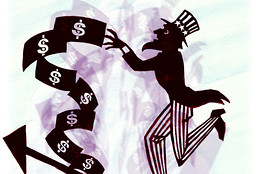- smaller
- Larger
By BILL MCNABB
Anyone hoping for signs of a healthy economic recovery was disappointed by lower-than-expected GDP growth for the first quarter of 2013—a mere 2.5%, far short of the forecast 3.2%. Meanwhile, the stock market continues to soar, hitting record levels in recent weeks. It's a striking disconnect, and one that is discouraging and confusing for Americans as they seek to earn a living and save for the future.Companies and small businesses are also dealing with the same paradox. Many are in good shape and have money to spend. So why aren't they pumping more capital back into the economy, creating jobs and fueling the country's economic engine?
Quite simply, if firms can't see a clear road to economic recovery ahead, they're not going to hire and they're not going to spend. It's what economists call a "deadweight loss"—loss caused by inefficiency.
Today, there is uncertainty about regulatory policy, uncertainty about monetary policy, uncertainty about foreign policy and, most significantly, uncertainty about U.S. fiscal policy and the national debt. Until a sensible plan is created to address the debt, America will not fulfill its economic potential.
Uncertainty comes with a very real and quantifiable price tag—an uncertainty tax, so to speak. Over the past two years, amid stalled debates in Washington and missed opportunities to tackle the debt, the magnitude of this uncertainty tax has gotten short shrift.
Three economists, Stanford University's Nicholas Bloom and Scott Baker and the University of Chicago's Steven Davis, have done invaluable work measuring the level of policy uncertainty over the past few decades. Their research (available at policyuncertainty.com) shows that, on average, U.S. economic policy uncertainty has been 50% higher in the past two years than it has been since 1985.
Mais

